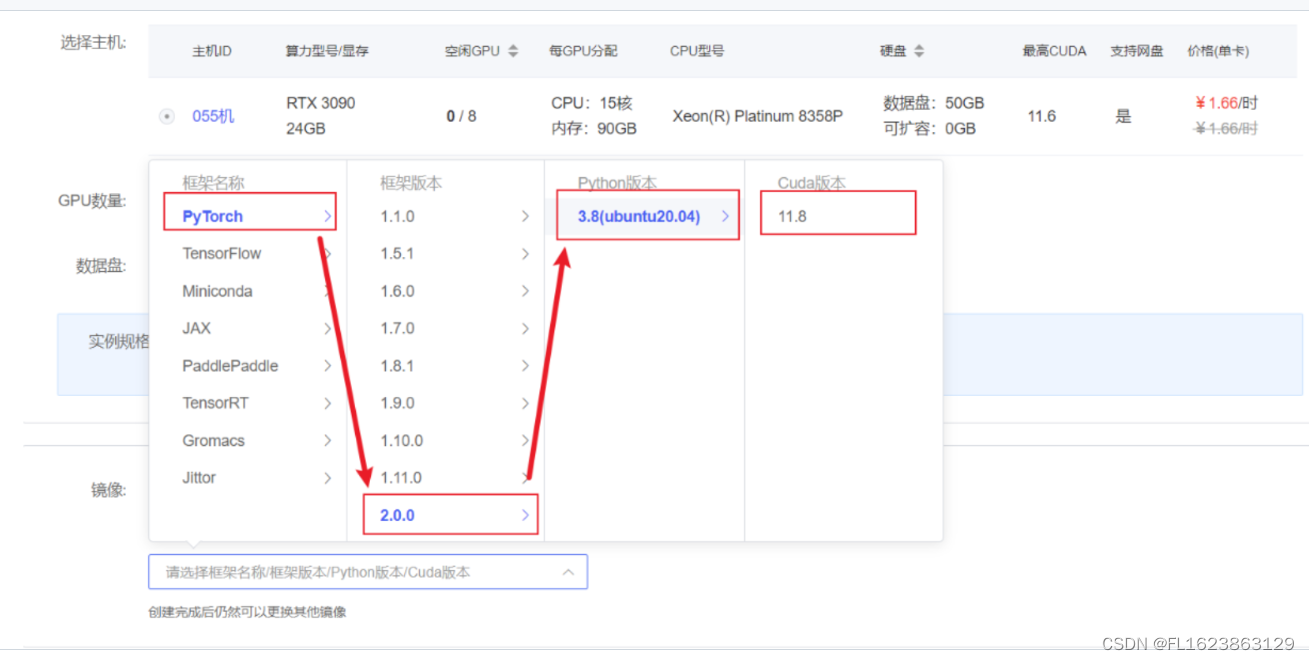Baichuan2 介绍
Baichuan 2 是百川智能推出的新一代开源大语言模型,采用 2.6 万亿 Tokens 的高质量语料训练。在多个权威的中文、英文和多语言的通用、领域 benchmark 上取得同尺寸最佳的效果。
环境准备

在autodl平台中租一个3090等24G显存的显卡机器,如下图所示镜像选择PyTorch-->2.0.0-->3.8(ubuntu20.04)-->11.8(11.3版本以上的都可以) 接下来打开刚刚租用服务器的JupyterLab, 图像 并且打开其中的终端开始环境配置、模型下载和运行演示。
pip换源和安装依赖包
# 升级pip python -m pip install --upgrade pip # 更换 pypi 源加速库的安装 pip config set global.index-url https://pypi.tuna.tsinghua.edu.cn/simplepip install fastapi==0.104.1 pip install uvicorn==0.24.0.post1 pip install requests==2.25.1 pip install modelscope==1.9.5 pip install transformers==4.35.2 pip install streamlit==1.24.0 pip install sentencepiece==0.1.99 pip install accelerate==0.24.1 pip install transformers_stream_generator==0.0.4 pip install xformers==0.0.23
模型下载:
使用 modelscope 中的snapshot_download函数下载模型,第一个参数为模型名称,参数cache_dir为模型的下载路径。
在 /root/autodl-tmp 路径下新建 download.py 文件并在其中输入以下内容,粘贴代码后记得保存文件,如下图所示。并运行 python /root/autodl-tmp/download.py 执行下载,模型大小为15 GB,下载模型大概需要10~20分钟
import torch
from modelscope import snapshot_download, AutoModel, AutoTokenizer
import os
model_dir = snapshot_download('baichuan-inc/Baichuan2-7B-Chat',cache_dir='/root/autodl-tmp', revision='v1.0.4')
代码准备:
在/root/autodl-tmp路径下新建api.py文件并在其中输入以下内容,粘贴代码后记得保存文件。下面的代码有很详细的注释,大家如有不理解的地方,欢迎提出issue。
from fastapi import FastAPI, Request
from transformers import AutoTokenizer, AutoModelForCausalLM
from transformers.generation.utils import GenerationConfig
import uvicorn
import json
import datetime
import torch# 设置设备参数
DEVICE = "cuda" # 使用CUDA
DEVICE_ID = "0" # CUDA设备ID,如果未设置则为空
CUDA_DEVICE = f"{DEVICE}:{DEVICE_ID}" if DEVICE_ID else DEVICE # 组合CUDA设备信息# 清理GPU内存函数
def torch_gc():if torch.cuda.is_available(): # 检查是否可用CUDAwith torch.cuda.device(CUDA_DEVICE): # 指定CUDA设备torch.cuda.empty_cache() # 清空CUDA缓存torch.cuda.ipc_collect() # 收集CUDA内存碎片# 创建FastAPI应用
app = FastAPI()# 处理POST请求的端点
@app.post("/")
async def create_item(request: Request):global model, tokenizer # 声明全局变量以便在函数内部使用模型和分词器json_post_raw = await request.json() # 获取POST请求的JSON数据json_post = json.dumps(json_post_raw) # 将JSON数据转换为字符串json_post_list = json.loads(json_post) # 将字符串转换为Python对象prompt = json_post_list.get('prompt') # 获取请求中的提示# 构建 messages messages = [{"role": "user", "content": prompt}]result= model.chat(tokenizer, messages)now = datetime.datetime.now() # 获取当前时间time = now.strftime("%Y-%m-%d %H:%M:%S") # 格式化时间为字符串# 构建响应JSONanswer = {"response": result,"status": 200,"time": time}# 构建日志信息log = "[" + time + "] " + '", prompt:"' + prompt + '", response:"' + repr(result) + '"'print(log) # 打印日志torch_gc() # 执行GPU内存清理return answer # 返回响应# 主函数入口
if __name__ == '__main__':# 加载预训练的分词器和模型tokenizer = AutoTokenizer.from_pretrained("/root/autodl-tmp/baichuan-inc/Baichuan2-7B-Chat", trust_remote_code=True)model = AutoModelForCausalLM.from_pretrained("/root/autodl-tmp/baichuan-inc/Baichuan2-7B-Chat", trust_remote_code=True).to(torch.bfloat16).cuda()g_config = GenerationConfig.from_pretrained("/root/autodl-tmp/baichuan-inc/Baichuan2-7B-Chat")g_config.temperature = 0.3 # 可改参数:温度参数控制生成文本的随机性。较低的值使输出更加确定性和一致。g_config.top_p = 0.85 # 可改参数:top-p(或nucleus sampling)截断,只考虑累积概率达到此值的最高概率的词汇。g_config.top_k = 5 # 可改参数:top-k截断,只考虑概率最高的k个词汇。g_config.max_new_tokens = 2048 # 可改参数:设置生成文本的最大长度(以token为单位)。model.generation_config = g_configmodel.eval() # 设置模型为评估模式# 启动FastAPI应用# 用6006端口可以将autodl的端口映射到本地,从而在本地使用apiuvicorn.run(app, host='0.0.0.0', port=6006, workers=1) # 在指定端口和主机上启动应用
Api 部署:
在终端输入以下命令启动api服务
cd /root/autodl-tmp python api.py
加载完毕后出现如下信息说明成功。

默认部署在 6006 端口,通过 POST 方法进行调用,可以使用curl调用,如下所示:
curl -X POST "http://127.0.0.1:6006"
-H 'Content-Type: application/json'
-d '{"prompt": "你是谁"}'
得到的返回值如下所示:
{'response': '我是百川大模型,是由百川智能的工程师们创造的大语言模型', 'status': 200, 'time': '2023-12-01 17:06:10'
}
运行显示:

也可以使用python中的requests库进行调用,如下所示:
import requests
import jsondef get_completion(prompt):headers = {'Content-Type': 'application/json'}data = {"prompt": prompt}response = requests.post(url='http://127.0.0.1:6006', headers=headers, data=json.dumps(data))return response.json()['response']if __name__ == '__main__':print(get_completion('你是谁,请给我介绍下自己'))
运行显示:


)

rebase(十六))
)












)
)